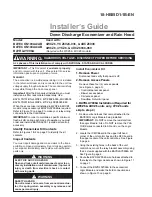
27
Safety Precautions
3. Repairs to sealed components
• During repairs to sealed components, all
electrical supplies shall be disconnected from
the equipment being worked upon prior to any
removal of sealed covers, etc.
• If it is absolutely necessary to have an
electrical supply to equipment during
servicing, then a permanently operating
form of leak detection shall be located at the
most critical point to warn of a potentially
hazardous situation.
• Particular attention shall be paid to the
following to ensure that by working on
electrical components, the casing is not
altered in such a way that the level of
protection is affected. This shall include
damage to cables, excessive number of
connections, terminals not made to original
speci
fi
cation, damage to seals, incorrect
fi
tting
of glands, etc.
• Ensure that apparatus is mounted securely.
• Ensure that seals or sealing materials have
not degraded such that they no longer serve
the purpose of preventing the ingress of
fl
ammable atmospheres.
• Replacement parts shall be in accordance
with the manufacturer’s speci
fi
cations.
NOTE: The use of silicon sealant may inhibit
the effectiveness of some types of leak
detection equipment.
Intrinsically safe components do not have to be
isolated prior to working on them.
4. Repair to intrinsically safe components
• Do not apply any permanent inductive or
capacitance loads to the circuit without
ensuring that this will not exceed the
permissible voltage and current permitted for
the equipment in use.
• Intrinsically safe components are the only
types that can be worked on while live in the
presence of a
fl
ammable atmosphere.
• The test apparatus shall be at the correct
rating.
• Replace components only with parts speci
fi
ed
by the manufacturer. Unspeci
fi
ed parts by
manufacturer may result ignition of refrigerant
in the atmosphere from a leak.
5. Cabling
• Check that cabling will not be subject
to wear, corrosion, excessive pressure,
vibration, sharp edges or any other adverse
environmental effects.
• The check shall also take into account the
effects of aging or continual vibration from
sources such as compressors or fans.
6. Detection of
fl
ammable refrigerants
• Under no circumstances shall potential
sources of ignition be used in the searching or
detection of refrigerant leaks.
• A halide torch (or any other detector using a
naked
fl
ame) shall not be used.
7. The following leak detection methods
are deemed acceptable for all refrigerant
systems
• No leaks shall be detected using detection
equipment with sensitivity to detect leakage
of 5g/year of refrigerant or better under a
pressure of at least 0.25 times the maximum
allowable pressure (>1.04 MPa, max 4.15
MPa), for example, a universal sniffer.
• Electronic leak detectors may be used
to detect
fl
ammable refrigerants, but the
sensitivity may not be adequate, or may need
re-calibration.
(Detection equipment shall be calibrated in a
refrigerant-free area.)
• Ensure that the detector is not a potential
source of ignition and is suitable for the
refrigerant used.
• Leak detection equipment shall be set at a
percentage of the LFL of the refrigerant and
shall be calibrated to the refrigerant employed
and the appropriate percentage of gas (25 %
maximum) is con
fi
rmed.
• Leak detection
fl
uids are also suitable for use
with most refrigerants, for example, bubble
method and
fl
uorescent method agents. The
use of detergents containing chlorine shall
be avoided as the chlorine may react with the
refrigerant and corrode the copper pipe-work.
• If a leak is suspected, all naked
fl
ames shall
be removed/extinguished.
• If a leakage of refrigerant is found which
requires brazing, all of the refrigerant shall
be recovered from the system, or isolated
(by means of shut off valves) in a part of the
system remote from the leak. The precautions
in #8 must be followed to remove the
refrigerant.
English
Summary of Contents for RS-LZ9ZK
Page 4: ...4...
Page 5: ...5 ON Ni Cd ELCB RCD ELCB BS...
Page 7: ...7 e f g h i j 5 0 25 1 04 MPa 4 15 MPa 1 A Amin m 12 2 2 1 2 2 2 2 2 8 2 2...
Page 8: ...8 2 3 2 4 CO2 2 5 2 6 2 7 2 8...
Page 9: ...9 6 7 5 1 04 MPa 4 15 MPa 0 25 LFL 25 8 3 4 5...
Page 10: ...10 10 a b c d e f g h 80 i j k 11 8 OFN OFN OFN OFN 9 OFN 7...
Page 11: ...11 12...
Page 16: ...16 POWER TIMER ON 30 TIMER ON 30 nanoe G HEAT COOL nanoe G nanoe G...
Page 19: ...19 Pb...
Page 38: ...Memo...
Page 39: ...Memo...














































